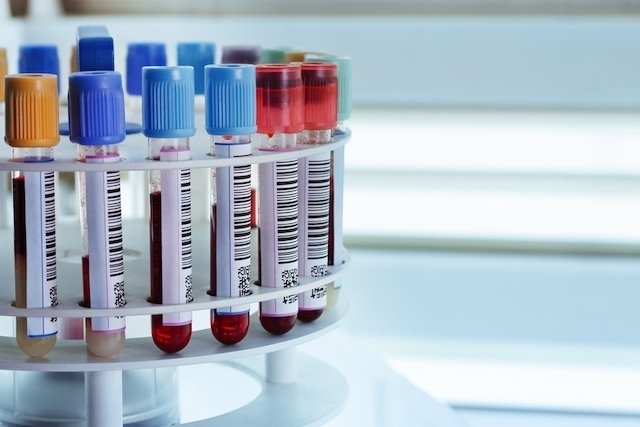Aplastic anemia is a rare and serious hematological disease in which the bone marrow stops or reduces the production of new blood cells, such as red blood cells, leukocytes and platelets, resulting in symptoms such as paleness, excessive tiredness, frequent infections and the appearance of purple spots on the skin. without apparent cause.
This type of anemia, also called aplastic anemia, can be present from birth or be acquired over time, due to the use of some medications, frequent contact with chemical substances, viral infections or autoimmune diseases, for example.
The treatment of aplastic anemia is carried out by a hematologist, according to its cause, and blood transfusions, the use of immunosuppressive drugs, bone marrow stimulants or even a bone marrow transplant may be indicated.

Aplastic anemia symptoms
The main symptoms of aplastic anemia are:
- Paleness of the skin and mucous membranes;
- Purple marks on the skin for no apparent reason;
- Excessive tiredness;
- Weakness that gradually worsens;
- Shortness of breathe;
- Fast or irregular heartbeat;
- Nose bleed;
- Bleeding gums;
- Large hemorrhages even in small cuts;
- Dizziness;
- Headache;
- Blisters on the skin;
- Frequent or persistent infections;
- Sudden onset fever.
Furthermore, in some cases there may also be kidney and urinary tract changes, these changes being more frequent in the case of Fanconi anemia, which is a type of congenital aplastic anemia. Learn more about Fanconi anemia.
The symptoms of aplastic anemia may arise due to the decrease in red blood cells, which are responsible for bringing oxygen to all tissues in the body, leukocytes, which are cells that are part of the immune system in fighting bacteria, viruses and fungi, and platelets in the blood, which participate of blood clotting, this condition being called pancytopenia.
It is important to consult a hematologist whenever symptoms of aplastic anemia appear to begin the most appropriate treatment, according to its cause, as it is a serious condition that can be life-threatening if not treated properly.
How the diagnosis is made
The diagnosis of aplastic anemia is made by the hematologist through the evaluation of symptoms, health history, and analysis of laboratory tests, mainly the blood count, which indicates quantities below the reference values for red blood cells, leukocytes and platelets.
To confirm the diagnosis, the doctor usually requests a myelogram, which aims to assess how the bone marrow is producing cells, and a bone marrow biopsy may also be recommended. Understand what a bone marrow biopsy is for and how it is done.
In some cases, especially when it is found that aplastic anemia is congenital, the doctor may request imaging tests to evaluate the urinary tract and kidneys, in addition to laboratory tests that evaluate this system, such as urea and creatinine, for example. .
Which doctor to consult?
The specialist doctor to identify and treat aplastic anemia is the hematologist, both for congenital and acquired aplastic anemia.
Taking care of your health has never been easier!
Possible causes
Aplastic anemia is caused by an insufficiency of the bone marrow, which is responsible for producing blood cells, resulting in a decrease or absence of production of red blood cells, leukocytes and platelets, and the appearance of symptoms.
Aplastic anemia can be acquired and develop over time and may be related to:
- Pregnancy;
- Use of medications, such as antibiotics or medicines to treat rheumatoid arthritis;
- Cancer treatment, such as chemotherapy or radiotherapy;
- Frequent exposure to some toxic substances, such as bismuth, pesticides, insecticides, chloramphenicol, gold salts and petroleum products;
- Autoimmune diseases, such as eosinophilic fasciitis;
- Viral infections, such as hepatitis, cytomegalovirus or HIV.
Furthermore, aplastic anemia can occur due to congenital causes, in which the child is born with this change, developing symptoms in the first years of life, in which case it is called congenital aplastic anemia.
How the treatment is carried out
The treatment of aplastic anemia must be carried out under the guidance of a hematologist, according to its cause, and aims to alleviate symptoms and stimulate the bone marrow to produce blood cells in sufficient quantity that can perform their functions.
The main treatments for aplastic anemia that may be recommended by your doctor are:
- red blood cell transfusion, to increase the amount of oxygen being transported by cells, reducing fatigue and excessive tiredness;
- Platelet transfusionto prevent bleeding or hemorrhage;
- Antibiotics, antivirals or antifungalsto prevent or treat infections;
- Bone marrow stimulantssuch as filgrastim, pegfilgrastim, epoetin alfa, or eltrombopag olamine;
- Immunosuppressantssuch as cyclosporine and methylprednisolone, indicated for people with autoimmune diseases or who cannot have a bone marrow transplant.
Despite these treatments, it is not always possible to cure aplastic anemia. Bone marrow transplantation, in which the person receives marrow that functions perfectly, promoting the formation of blood cells in ideal quantities, is sometimes effective in controlling the disease when associated with immunosuppressants. Understand what bone marrow transplantation is and how it works.
In the case of aplastic anemia associated with pregnancy, treatment usually involves blood transfusions, and after birth the disease generally improves. However, if there is no improvement, treatment should be guided by the hematologist.
Bibliography
- SCHOETTLER, M. L.; NATHAN, D. G. The Pathophysiology of Acquired Aplastic Anemia: Current Concepts Revisited. Hematol Oncol Clin North Am. 32. 4; 581-594, 2018
- BACIGALUPO, A. How I treat acquired aplastic anemia. Blood. 129. 11; 1428-1436, 2017
- PIERRI, F.; DUFOUR, C. Management of aplastic anemia after failure of frontline immunosuppression. Expert Rev Hematol. 12. 10; 809-819, 2019
- GEORGE, GE; et al. Severe aplastic anemia: allogeneic bone marrow transplantation as first-line treatment. Blood Adv. 2. 15; 2020-2028, 2018
- MOORE, C. A.; KRISHNAN, K. IN: STATPEARLS (INTERNET). TREASURE ISLAND (FL): STATPEARLS PUBLISHING. Aplastic Anemia. 2022. Available at: <https://www.ncbi.nlm.nih.gov/books/NBK534212/>. Accessed on February 3, 2023
- DeZERN, AE; CHURPEK, J.E. Approach to the diagnosis of aplastic anemia. Blood Adv. 5. 12; 2660-2671, 2021
- WANG, L.; LIU, H. Pathogenesis of aplastic anemia. Hematology. 24. 1; 559-566, 2019
- HARTUNG, HD; et al. Acquired aplastic anemia in children. Pediatr Clin North Am. 60. 6; 1311-36, 2013
- MINISTRY OF HEALTH. Clinical Protocol and Therapeutic Guidelines Ordinance – Acquired Aplastic Anemia. 2013. Available at: <https://www.saude.gov.br/images/pdf/2014/abril/02/pcdt-anemia-apl-adq-livro-2013.pdf>. Accessed on April 23, 2020
- HEMORIO. Aplastic Anemia. Available at: <http://www.hemorio.rj.gov.br/Html/pdf/Manuais/Anemia_Aplastica.pdf>. Accessed on April 23, 2020

Sign up for our newsletter and stay up to date with exclusive news
that can transform your routine!
Warning: Undefined array key "title" in /home/storelat/public_html/wp-content/plugins/link-whisper-premium/templates/frontend/related-posts.php on line 12
Warning: Undefined array key "title_tag" in /home/storelat/public_html/wp-content/plugins/link-whisper-premium/templates/frontend/related-posts.php on line 13



